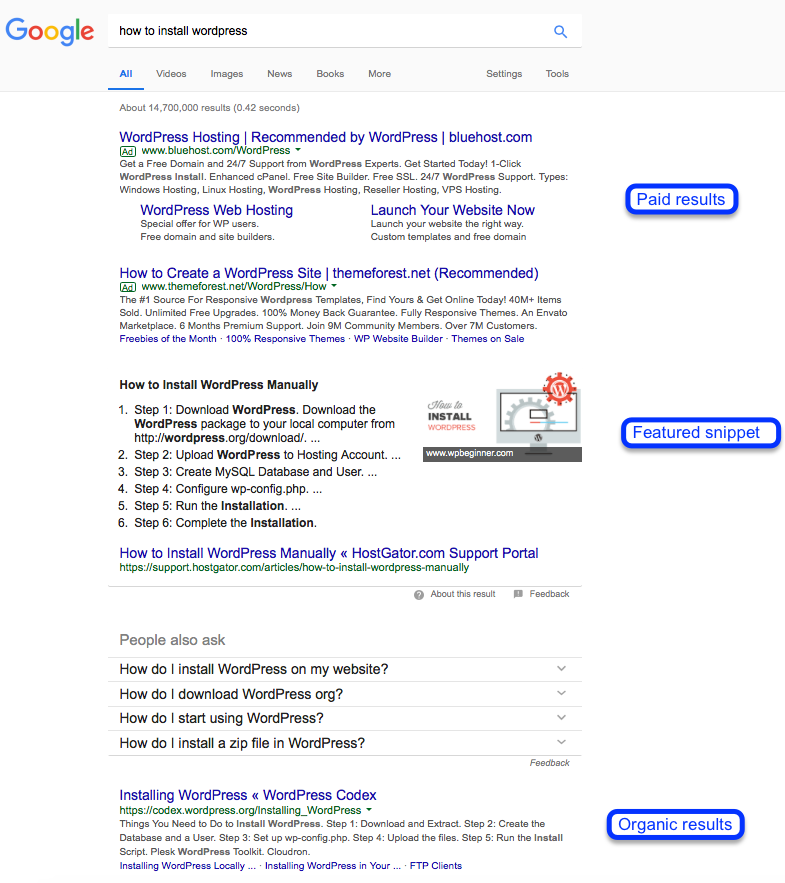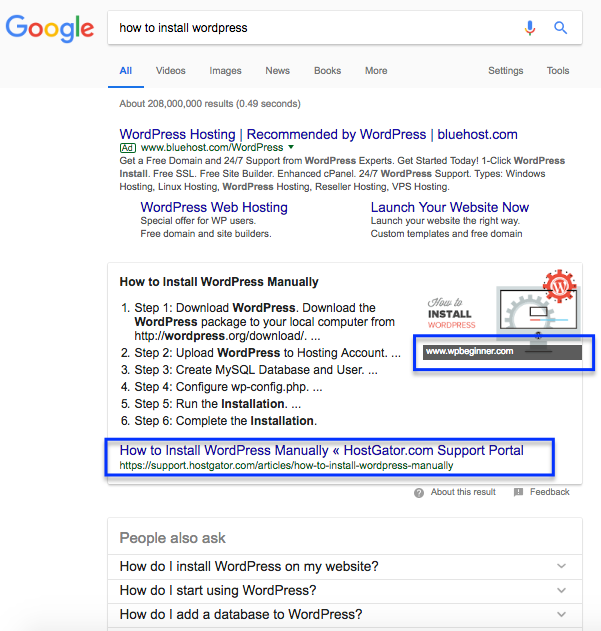Google’s Featured Snippets Optimization
What is a featured snippet?
When we analyze the overall usage of the search engines, and when we compare the results, there is no doubt that Google takes precedence over all the others. Based on this research, it has a 90% share in the search engine market share worldwide.

When we analyze the overall usage of the search engines, and when we compare the results, there is no doubt that Google takes precedence over all the others. Based on this research, it has a 90% share in the search engine market share worldwide.
It’s only natural to keep up with the updates and explore the options Google offers for positioning your content on the internet. One of those options includes featured snippets.
 What is different about this snippet, compared to the regular search result, is the fact that it’s more highlighted. It also provides a summary of page content that directly answers the question used in the search query.
The goal with featured snippet is to show the answer to the question, without even the need for the user to click on the page. This is why featured snippets are mainly used with queries that ask for a specific question. Using a featured snippet, Google gives the online users a brief answer instantly, without the need to look through the article.
Featured snippet includes:
What is different about this snippet, compared to the regular search result, is the fact that it’s more highlighted. It also provides a summary of page content that directly answers the question used in the search query.
The goal with featured snippet is to show the answer to the question, without even the need for the user to click on the page. This is why featured snippets are mainly used with queries that ask for a specific question. Using a featured snippet, Google gives the online users a brief answer instantly, without the need to look through the article.
Featured snippet includes:
 As for webmasters, this might become a problem because one day you might notice an image of your competitor right next to your summary. The traffic will be divided between these two links. This means the link will receive less traffic than in case there was only one link. Also, your content might be featured next to an image you are not happy with and doesn’t reflect your attitude.
Unfortunately, there isn’t much to do about it. You can block featured snippets to be taken from your content. However, this way you risk losing the significant amount of exposure. Otherwise, you can try providing feedback to Google about this featured snippets you are having issues with. Neither of these is a guarantee that the search engine will change this in the future.
As for webmasters, this might become a problem because one day you might notice an image of your competitor right next to your summary. The traffic will be divided between these two links. This means the link will receive less traffic than in case there was only one link. Also, your content might be featured next to an image you are not happy with and doesn’t reflect your attitude.
Unfortunately, there isn’t much to do about it. You can block featured snippets to be taken from your content. However, this way you risk losing the significant amount of exposure. Otherwise, you can try providing feedback to Google about this featured snippets you are having issues with. Neither of these is a guarantee that the search engine will change this in the future.
What is a featured snippet?
A featured snippet is a search result shown at the top of the search engine results page. It’s shown as a response to a search query. Usually, it’s a question query with words like how to, what is, when to, where is… Even though they are shown on top of the page before organic results, featured snippets are still below the search engine ads. So the order is the following:- Paid results (if there are any)
- Featured snippet
- Organic search results
 What is different about this snippet, compared to the regular search result, is the fact that it’s more highlighted. It also provides a summary of page content that directly answers the question used in the search query.
The goal with featured snippet is to show the answer to the question, without even the need for the user to click on the page. This is why featured snippets are mainly used with queries that ask for a specific question. Using a featured snippet, Google gives the online users a brief answer instantly, without the need to look through the article.
Featured snippet includes:
What is different about this snippet, compared to the regular search result, is the fact that it’s more highlighted. It also provides a summary of page content that directly answers the question used in the search query.
The goal with featured snippet is to show the answer to the question, without even the need for the user to click on the page. This is why featured snippets are mainly used with queries that ask for a specific question. Using a featured snippet, Google gives the online users a brief answer instantly, without the need to look through the article.
Featured snippet includes:
- Summary of the webpage
- Link to the page
- Page title and URL
- Image (Optional)
About the results in the featured snippets
The summary shown in the featured snippets is extracted from the web page. Link to this page is also included in the featured snippets. The content summary is automatically created by the search engine algorithm that detects the most helpful pages. A part of the page that answers the query is then highlighted as a part of featured snippets. Of course, this isn’t a flawless system. Having in mind that the whole process is done automatically, there might be errors along the way. This is why Google enables online users to give feedback about the results they see. Also, this is the reason why featured snippets often change. Seeing a specific page in the featured snippets once doesn’t mean it will be there again next time the same question is used in the search query.Opt in or out
There is no way to opt in or to mark a specific page of your website or blog to be included in the featured snippets. Google does the process automatically which means that every page can potentially be featured here. When it comes to opting out, there is a way to prevent the search engines from accessing your page and using its content for the featured snippets. You’ll use the following tag in such a case: Just use this tag on the page you want to exclude from the featured snippets results.Images in the snippets
What raised a lot of debate among the webmasters is when Google started showing images within featured snippets. The main problem with this is that the image from a different source may be featured. So, look at this example. We have a featured snippet summary and the corresponding link below. And then there is an image with a different URL. This can confuse some users. Once they click the link on the image, they will be taken to a page that doesn’t have this summary they’ve just seen in the results. If they go for the link from the summary, they won’t see the image. As for webmasters, this might become a problem because one day you might notice an image of your competitor right next to your summary. The traffic will be divided between these two links. This means the link will receive less traffic than in case there was only one link. Also, your content might be featured next to an image you are not happy with and doesn’t reflect your attitude.
Unfortunately, there isn’t much to do about it. You can block featured snippets to be taken from your content. However, this way you risk losing the significant amount of exposure. Otherwise, you can try providing feedback to Google about this featured snippets you are having issues with. Neither of these is a guarantee that the search engine will change this in the future.
As for webmasters, this might become a problem because one day you might notice an image of your competitor right next to your summary. The traffic will be divided between these two links. This means the link will receive less traffic than in case there was only one link. Also, your content might be featured next to an image you are not happy with and doesn’t reflect your attitude.
Unfortunately, there isn’t much to do about it. You can block featured snippets to be taken from your content. However, this way you risk losing the significant amount of exposure. Otherwise, you can try providing feedback to Google about this featured snippets you are having issues with. Neither of these is a guarantee that the search engine will change this in the future.
How to optimize for Google featured snippets
Now that you know everything you need to know about featured snippets, let’s explore ways to optimize your content to be included in the featured snippets. Bear in mind that even Google says that it isn’t possible to affect or mark content to be a part of featured snippets. However, experienced webmasters believe that following good practices can increase the chances for content to become a part of a featured snippet.Pages that rank high
This is a crucial information you need to know about featured snippets. Most results that get featured are already ranked pretty high in the search engine results. This means the starting point should be optimizing your web pages. While the entire website and all of its pages need optimization and you need to go through all of the suggestions related to improving the ranking of a page, the particular page you are hoping to rank high is the one that deserves most attention. Go through all of the optimization elements. Make sure your content is accessible to the search engines. Also, explore the topic of SEO a little bit more. Try to discover other ways to optimize the page, other than on-site SEO. In particular, explore link building and how this could help you improve ranking. Here’s a helpful guide regarding search engine optimization with practical suggestions on how to optimize your content immediately: Search Engine Optimization Fundamentals Course.New content
There are many factors that affect how Google ranks websites. The exact formula will never be known because it would lead to manipulations. However, it’s strongly believed that freshness has an impact on ranking pages. In particular, online marketers think that Google is more likely to rank new pages first. The reasoning behind this is the following. Content can become obsolete. New practices and new ways of doing things are constantly introduced in any industry you might be working in. And since Google wants the most relevant results to be displayed in the search engines, it’s only natural to expect it would count publishing date as a factor. This could motivate you to start publishing regularly, analyzing even the topics you have already covered. It should also encourage you to occasionally update the old content. When updating content, you’ll change the publishing date to a newer date which will appear more recent. The next step is reviewing the content. Sometimes, when the content is evergreen, you don’t need to make many changes. When you notice parts of the content that are obsolete, not current, or even wrong, adjust the content before republishing. Finally, re-upload the images. When uploaded, the images contain the date, and if they appear in the new article, this might negatively affect the freshness of your content. Since images are often part of featured snippets, you need them to appear fresh as much as the rest of the content.Find questions
A great way to increase the chances of getting your content in the featured snippets is finding perfect questions to answer. Although there is so much content online, and even though it might seem that you don’t really need to answer any questions, that you don’t have new questions, a significant number of searches conducted on Google every day are completely new. As for the old ones, ones that supposedly have been answered, you need to have in mind that we’ve already mentioned that summaries shown in the featured snippets change. They aren’t set in stone, and you can get results there even if there already is content that answers a certain query. Here are a couple of strategies:- Detect questions that can be answered in a better, more useful way
- Pay attention to the questions shown in the box below the featured snippet. This section is called “People also ask”.
- Scroll down to the end of the search engine result page to discover related searches
- Play around with Google and test paraphrasing the questions to discover any questions with no featured snippet yet
- Determine the keywords or keyword phrases for which you already rank high, because these have the highest chance of being included in the featured snippets.
Think about your answers
Now that you have questions, it’s time to answer those questions. Now it’s time to focus on the actual content that gets featured. You need to think about the answers. Try to formulate an answer that you can actually envisage as a featured snippet. Here are a couple of aspects to think about:- Concise answer
- Articles with multiple answers
- Organization is a key aspect
